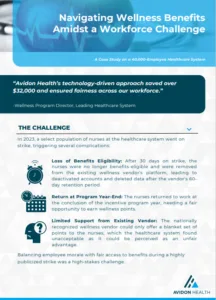Features of Successful Employee Wellness Programs
As we prepare for 2025, companies need more than just competitive salaries and traditional benefits to attract and retain top talent. Employee wellness programs have become essential for fostering a healthier, happier, and more engaged workforce. These programs not only improve employee health but also enhance productivity, reduce absenteeism, and boost morale.
In fact, 49% of small to midsized organizations now prioritize employee well-being. Below, we break down the 10 key features that define a successful wellness program and provide HR leaders with actionable insights to improve employee wellness and performance.
1. Holistic Approach to Wellness
Successful wellness programs are more than just physical health initiatives. They address all aspects of an employee’s well-being—mental, emotional, financial, and social. Employees today are seeking a balanced and supportive workplace that cares for their overall well-being.
- Example: Companies that offer mental health support and financial wellness programs often see a significant improvement in employee well-being. In fact, 76% of employees reported at least one symptom of a mental health condition in the past year. This highlights the growing need for a well-rounded wellness strategy that caters to diverse needs.
2. Accessibility and Inclusivity
The best wellness programs are accessible to all employees, whether they work on-site, remotely, or in hybrid roles. This is especially important as remote work continues to rise. Wellness programs should offer options for all employees, regardless of their physical location or working hours.
- Example: According to Gallup, 32% of remote employees report feeling disconnected from their company’s wellness initiatives. Providing virtual options, such as online fitness classes or mental health resources, helps engage remote employees and ensure everyone benefits from wellness initiatives.
3. Leadership Support and Participation
Wellness programs thrive when company leaders actively support and participate in them. When leaders model healthy behaviors and engage in wellness activities, employees are more likely to follow suit. Leadership buy-in also sends a strong message that the company truly values employee well-being.
- Example: Research from Gallup shows that employee engagement in wellness programs increases by 20-30% when company leaders actively participate. Leadership participation can range from joining wellness challenges to promoting mental health days.
4. Personalization Options
A one-size-fits-all approach to wellness doesn’t work. Employees have unique health needs and wellness goals, so offering personalized wellness options ensures higher participation and effectiveness. Whether it’s fitness goals, mental health needs, or financial planning, personalization allows employees to engage in a way that resonates with them.
- Example: Companies that integrate Diversity, Equity, and Inclusion (DEI) into their wellness programs see a 15% increase in participation among minority employees. Personalization goes hand in hand with inclusion, ensuring that all employees have access to resources that support their specific needs.
5. Regular Health Screenings and Assessments
Preventive care is a key part of maintaining employee health. Offering regular health screenings and assessments, such as biometric screenings, can help employees stay on top of their health and catch potential issues early. Health assessments not only improve individual health outcomes but also reduce long-term healthcare costs for the company.
- Example: Regular check-ups and screenings are a cornerstone of workplace wellness, helping employees understand their health better and take proactive measures to improve it. According to the CDC, wellness programs reduce absenteeism by 28%.
6. Incentives and Rewards
 Incentives play a major role in motivating employees to participate in wellness programs. When employees are rewarded for participating in activities or meeting wellness goals, they are more likely to stay engaged. Rewards can range from small perks like gift cards to larger incentives like extra vacation days or wellness-related prizes.
Incentives play a major role in motivating employees to participate in wellness programs. When employees are rewarded for participating in activities or meeting wellness goals, they are more likely to stay engaged. Rewards can range from small perks like gift cards to larger incentives like extra vacation days or wellness-related prizes.
- Example: According to a study in the Harvard Business Review, employees who are recognized and rewarded are 12 times more likely to be engaged and productive. Creating a rewards structure for wellness participation can boost engagement significantly.
7. Mental Health Resources
Mental health is no longer a “nice-to-have” but a critical component of employee wellness. As the workplace evolves, more companies are offering mental health resources, such as Employee Assistance Programs (EAPs), mental health apps, and counseling services. Supporting mental health not only improves employee well-being but also enhances productivity and reduces absenteeism.
- Example: With 76% of employees reporting at least one symptom of a mental health condition, providing accessible mental health resources is essential for any wellness program.
8. Flexible Work Options
Workplace flexibility is a growing demand among employees, especially in today’s hybrid work environments. Offering flexible work options, such as remote work, flexible hours, or compressed workweeks, reduces stress and enhances work-life balance, which is a key element of employee well-being.
- Example: Studies show that companies offering flexible work options report a 35% increase in employee satisfaction and reduced turnover.
9. Ongoing Education and Awareness
Wellness programs should be continuously evolving, and ongoing education is essential for keeping employees engaged. Hosting regular workshops, seminars, and webinars on topics like mental health, nutrition, and stress management keeps wellness top of mind and equips employees with the tools they need to improve their health.
- Example: Companies that offer monthly wellness workshops and educational content often see higher participation rates as employees are reminded of the value these programs offer.
10. Measurement and Feedback Mechanisms
To ensure a wellness program’s effectiveness, it’s essential to measure its impact and gather employee feedback. Tracking participation rates, health outcomes, and employee satisfaction with the program helps refine initiatives and demonstrates ROI.
- Example: 58% of small businesses feel constrained by budgets in offering wellness programs. Measuring the ROI and Value on Investment (VOI) of wellness programs can provide the data needed to continue investing in employee well-being.
Conclusion
By implementing these 10 key features, companies can develop comprehensive and successful wellness programs that not only improve employee health but also positively impact the bottom line. Whether your goal is to reduce absenteeism, boost productivity, or foster a more engaged workforce, wellness programs are a strategic investment for today’s business environment.
Start small by introducing one of these features today, and watch your wellness culture grow into a powerful tool for employee well-being and company success.



 You might think that behavior modification only works for highly motivated people—those who already have the drive to make changes. This couldn’t be further from the truth. Motivation is not a static trait; it can be cultivated and strengthened.
You might think that behavior modification only works for highly motivated people—those who already have the drive to make changes. This couldn’t be further from the truth. Motivation is not a static trait; it can be cultivated and strengthened.




















